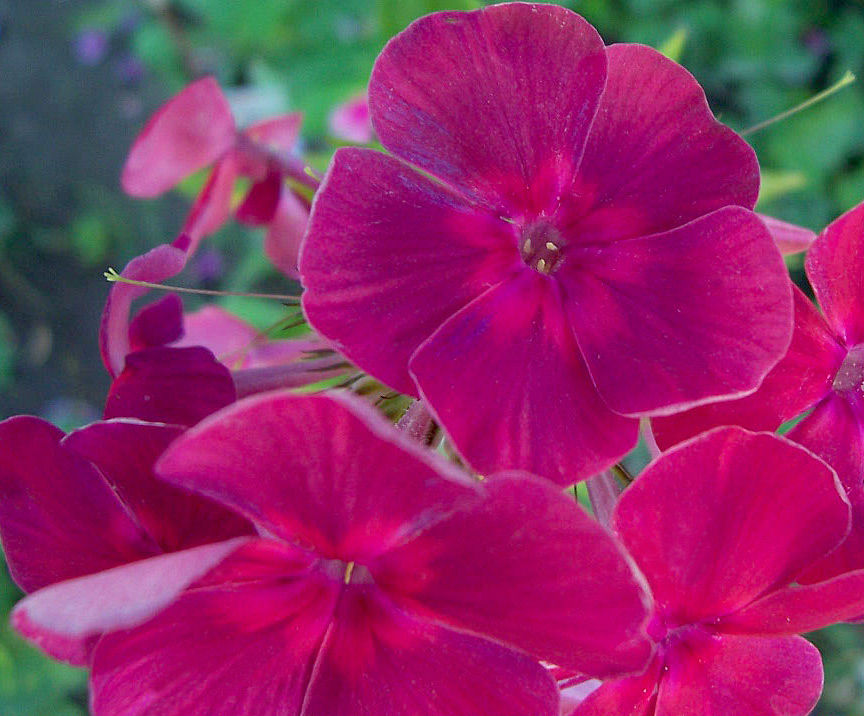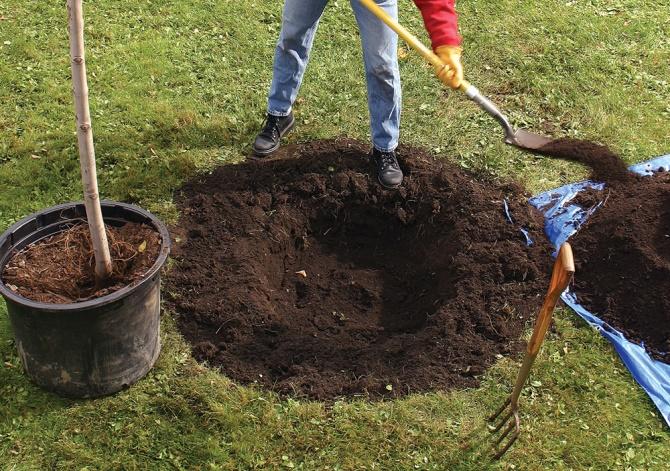Content:
The perennial garden flower phlox paniculata has many varieties that differ from each other not only in size, but also in the shade of the inflorescences, the duration of flowering and other characteristics. This species has gained immense popularity due to its unpretentious care, endurance, and also an extremely pleasant aroma.
Features of the view
The ancestors of the modern garden phlox paniculata are native to Greece and had bright red flowers. Modern varieties are divided into short and tall, with the maximum height reaching 1.5 m. Without exception, all varieties have a pleasant aroma, which is especially enhanced in the evening and is heard from afar in calm weather.
The leaves of the flower are small in size, oval-lanceolate, located on the stem below the inflorescences opposite each other. Each flower has 5 petals, 5 stamens and 1 pistil. The petals form a funnel with a diameter of 3-4 cm. The shape of a complex inflorescence has a special name - thyrsus. After the corolla wilts, the fruit ripens - a box, inside which there are small black or dark brown seeds (1-2 mm in diameter).
By combining different varieties in one flowerbed, you can easily achieve continuous flowering from May to October. One flower lives for 7 days, but several dozen of them grow on each stem. As soon as all the flowers wilt, the seeds ripen and the ground part of the plant gradually dies off. At the same time, buds are laid underground, from which new stems will sprout next spring. So year after year, one seedling will continuously expand its territory, decorating a private courtyard.
TOP 10 varieties of phlox paniculata
The following varieties have earned the highest marks from gardeners:
- Phlox Lizzie. Bush 70 cm high with bright pink inflorescences with a light core. The flowers are small - up to 3 cm in diameter. Feels good in sunny and slightly shaded areas, and in the second case, the flowering is brighter.
- Phlox Europe. A winter-hardy variety with a bush height of up to 1 m. Forms lush white inflorescences with flowers up to 4.5 cm in diameter with a pale pink heart. Flowering lasts from July to the end of September. Differs in resistance to disease. It tolerates a lack of light well. To preserve its decorative effect, the bush needs a rejuvenating transplant every 3-4 years.
- Phlox Phobos. The authorship of the variety belongs to the breeder Neretina M.I. The bush has a maximum height of 80 cm. The inflorescence consists of bright orange flowers with a crimson ring in the center, up to 5 cm in diameter. Flowering lasts from July to August. High winter hardiness, roots do not freeze even at -40 ºС.
- Phlox Orange Perfection. A low bush up to 70 cm well leafed. Blooms from July to August. The inflorescences have a bright orange-red color with a cherry spot in the center, flowers with a diameter of 3.5 cm. Average winter hardiness - withstands frost down to -29 ° C, therefore, does not require shelter.
- Phlox Old lighthouse. A relatively new variety, bred by the breeder Egorova V.I. in 2012, Silver-gray flowers up to 4 cm in diameter have a raspberry star in the center. The height of the bush reaches 70 cm. Flowering continues all summer.
- Phlox Grenadine Dream. Small bush - up to 60 cm. Small crimson-red flowers - up to 3.5 cm in diameter. Flowering lasts all summer, growth rate is high. In winter, it can withstand frosts down to -29 ° C.
- Phlox Franz Schubert.The bush is able to stretch up to 1 m in height. Flowers of a pale lilac color up to 4.5 cm in diameter change their shade at different times of the day, depending on temperature and illumination. The edges of the petals have a lighter shade. Blooms from June to July.
- Phlox Butonik. A very unusual variety that forms flowers that never bloom and freeze at the stage of pink-lilac buds. The bush is low - up to 50 cm. One of the few varieties that have no odor. Due to the fact that the inflorescence does not form seeds, reproduction is possible only by cuttings.
- Phlox Marshmallow. An impressively splendid variety with abundant white-pink blooms. Flowers up to 4.5 cm in diameter have a pink core and a wavy edge of the petals. A large bush grows up to 70 cm in height. In winter it can withstand frosts down to -40 ° С. Blooming does not stop from July to August.
- Phlox La Traviata. A spectacular plant with burgundy-crimson flowers up to 4 cm in diameter with a slightly darkened core and a slightly noticeable brown undertone along the edge of the wavy petals. The height of the bush is up to 70 cm, withstands frosts down to -40 ° C. Flowering time is from July to August.
Every year the counters of flower shops selling seeds are replenished with the latest varieties of phlox. The new shades are striking in their brightness and improved properties. The following varieties attract attention with the most positive reviews of gardeners and beautiful descriptions:
- phlox Dragon;
- phlox Success;
- phlox Cleopatra;
- phlox New;
- phlox Margry;
- phlox Forget-me-not;
- Olenka's phlox;
- phlox Margarita;
- phlox Nicky;
- phlox Twister;
- phlox Courage;
- phlox tenor;
- phlox Tiara;
- phlox Laura;
- phlox Cloud;
- phlox Heaven;
- phlox Indian summer;
- phlox Crown;
- phlox Cherished desire;
- phlox Zenobia;
- phlox Marie;
- phlox Dear friend;
- phlox Bright Ice;
- phlox Zaryadye;
- phlox Miss Mary;
- phlox Orange.
Rules for planting varieties of phlox paniculata and caring for them
The order of planting and caring for a plant is formed depending on the region in which it is grown. So, in the southern regions, mulching performs the function of retaining moisture, and in the northern regions - protecting the roots from freezing.
Reproduction
The easiest way to get a new bush is by removing some of the roots of the mother plant. This is done in early autumn or spring, when new shoots appear above the soil level. A good cut has 2-3 well-formed stems, and when planting, the deepening is performed only by 3-4 cm. Young cuttings, which are dug up in early June, take root perfectly. Usually it takes no more than a month to settle down in a new place. The method of rooting layers is also used. The stems are bent and attached to the ground, spudding with a mixture of humus and peat. By the fall, an independent bush will grow from such a layer.
If planting is carried out by seeds, then stratification is required. Sowing in seedling boxes is carried out a month before the expected date of disembarkation in open ground. Usually the end of May is chosen for this. It is advisable to prepare the soil in advance, clearing weeds, carefully digging up and adding a large amount of organic matter. The plant is very sensitive to abundant watering and soil fertility.
The place for planting is chosen so that a light partial shade falls on the bushes. This technique allows you to achieve brighter shades of inflorescences. The soil is sandy loam, slightly acidic. The flowerbeds are formed in such a way that the soil forms a light slope, along which melt water and rains will flow freely. Planting scheme from 35x35 cm to 50x50 cm, depending on the height of the variety. In one place, the bush feels good for 4-6 years.
Care
Lack of moisture in the soil is the most destructive for phlox. Thin shoots of the main roots are located at a depth of only 15 cm. Therefore, the soil under the bushes must not be allowed to dry completely. Lack of water affects the abundance of flowering, and the flowers themselves are much smaller.Normally, 1.5-2 buckets of water are poured under one bush in the morning. If tall varieties are selected, then by the end of July they will need support.
Before frosts come to the site, the bush must be completely cut off at the root. The center must be powdered with copper sulfate. All cut off parts must be burned. In order to avoid damage by powdery mildew, it is not recommended to thicken the bushes, as well as to plant them in depressions where puddles can form.
Top dressing
For the entire season, phlox will have to be fed only 3 times. For the first time, when young shoots grow back, nitrogen and complex fertilizers are applied. During the formation of buds, phosphorus-potassium mixtures are introduced. The same fertilizer must be applied after flowering is complete to prepare the bush for wintering. Manure is applied at the first planting, or in the spring when the soil thaws.
Tips & Tricks
Mulching is a desirable procedure that is required in both the southern and northern regions. The thing is that the phlox root system is prone to rapid growth. Young stems sprout from the buds underground, which at first grow horizontally, and then sharply unfold and continue to grow already upward. The knee formed underground grows woody and it is on it that the buds of the next year are laid in the fall. As a result, every year the rhizome lengthens by 1-3 cm, while approaching the soil surface. Over time, the roots begin to stick out from the ground, a serious problem rushes into the face. A bare rhizome in severe frost may die, or the buds will freeze. To prevent this, mulching is necessary.















